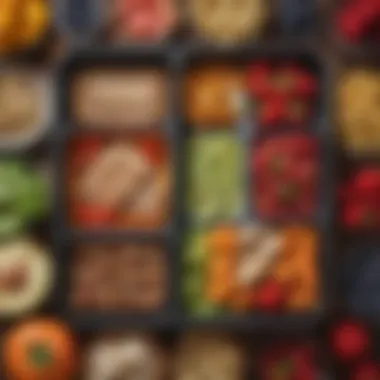Exploring Lunchbox Lunches: A Comprehensive Guide


Intro
Lunchbox lunches have become an integral part of daily routines for many. They are not just for children heading to school but for adults navigating busy workdays, too. The art of packing a practical lunch goes beyond mere convenience. It plays a significant role in health and wellness. This guide provides clarity on how to construct balanced meals that cater to a variety of dietary choices. Whether it is for picky eaters or health enthusiasts, there are ideas here for everyone. This will help not only to nourish the body but to also make meal times something to look forward to.
With so many factors to consider, from flavor combinations to nutrient density, the task can seem daunting. However, it can also be rewarding and enjoyable. Understanding how to select fresh ingredients, prepare them efficiently, and arrange them attractively can drastically improve one's lunch experience. The guide will cover types of lunchbox ideas, ingredient selections, and even time management strategies.
Unlock the potential of each meal packed into a lunchbox. With this approach, every lunch can be both tasty and nutritious. A well-packed lunch can prevent the common pitfalls of unhealthy snacking and provide energy throughout the day. Let's dive deeper into this multifaceted world.
Prelude to Lunchbox Lunches
The landscape of lunch has evolved significantly over the years. No longer is it simply about packing a sandwich and an apple. This article dives deep into the concept of lunchbox lunches, emphasizing their importance in contemporary meal planning for individuals of all ages.
Lunchbox lunches offer versatility. They can be tailored to meet dietary preferences, making them suitable for vegetarians, vegans, and those with specific allergies. Understanding the needs and preferences of the eater is crucial. This approach creates meals that are not only nutritious but also enjoyable.
Furthermore, these meals encourage individuals, particularly children, to develop a positive relationship with food. By being creative with lunch options, it can promote culinary curiosity. This exploration leads to a more adventurous palate, which is beneficial as one's dietary habits evolve.
In this guide, we will unravel key elements of lunchbox lunches such as nutritional importance, innovative ideas, and effective packing techniques. These insights are designed to assist anyone seeking to make well-balanced meals. Thereby, enhancing the lunch experience is a primary aim of this article.
Understanding the Value of Lunchbox Meals
Lunchbox meals present a myriad of benefits that extend beyond simple nourishment. They promote self-sufficiency, especially in children, teaching them how to choose and prepare their own meals. Involving children in the lunch packing process can increase their interest in healthy eating options. Furthermore, meal variety is a crucial aspect. Incorporating diverse food items ensures exposure to different flavors and textures, nurturing a well-rounded appetite.
Moreover, packing lunch is economical. Preparing meals at home typically costs less than purchasing cafeteria food or takeout. Families can control portions and ingredients, reducing waste and encouraging healthier choices. Importantly, a prepared lunch allows for better food safety, as proper storage methods can prevent spoilage and contamination.
"Packing a lunch is not just about food; it’s about fostering independence and encouraging healthy habits."
The Evolution of Lunchbox Culture
Lunchbox culture has a rich history, reflecting broader social and cultural transformations. In the past, lunches were often simple and utilitarian, comprised mostly of leftovers or easy-to-eat foods. However, globalization and increasing diversity in food choices have reshaped how we view and approach lunch.
Today’s lunchbox is a vibrant canvas. Trends have emerged, influenced by culinary innovations and societal shifts towards health consciousness. There’s a growing emphasis on visual appeal alongside nutritional content. Bento boxes, for example, highlight this trend by offering a visually appealing array of small portions, often inspired by various international cuisines.
Social media also plays a vital role in shaping lunchbox culture today. Platforms like Instagram showcase aesthetically pleasing meals, driving individuals to explore more creative and varied lunch options. This visibility often leads to a community-driven approach to meal planning, where ideas are shared and adapted across different households.
As we further investigate the nuances of lunchbox lunches in the sections ahead, it will become apparent how these concepts not only cater to individual tastes but also foster a culture of creativity and health consciousness.
Nutritional Considerations
Nutritional considerations play a pivotal role in the success of lunchbox meals. The food choices made for lunchbox lunches significantly impact both immediate energy levels and long-term health. Ensuring a well-balanced meal leads to better focus, mood stability, and overall well-being, especially for children and adolescents who need appropriate nutrients for growth and development.
Key Components of a Balanced Meal
A balanced meal generally includes a combination of proteins, carbohydrates, healthy fats, and vitamins and minerals. Each component serves a unique function:
- Proteins: Essential for building and repairing tissues. Good sources are turkey, beans, and cheese.
- Carbohydrates: The main energy source, found in whole grains, fruits, and vegetables.
- Healthy Fats: Important for brain function, sourced from avocados and nuts.
- Vitamins and Minerals: Crucial for overall bodily functions, available in colorful fruits and vegetables.
Combining these elements in the right proportions helps ensure children and adults receive adequate nutrition to meet daily needs.
Nutrient Density vs. Caloric Density
When choosing foods, one should consider nutrient density and caloric density. Nutrient-dense foods provide more vitamins and minerals relative to their caloric content. For instance, spinach is high in nutrients but low in calories, while potato chips have high calories but low nutrients. Focusing on nutrient-dense options is better for overall health, as they support energy levels without excessive calorie intake. This shifts the lunchbox focus from merely filling spaces to genuinely providing nourishing meals.
Addressing Dietary Restrictions
Gluten-Free Options


Gluten-free options appeal to those with celiac disease and gluten sensitivity. These meals often include rice, quinoa, and various fruits and vegetables. The key characteristic of gluten-free foods is their capacity to avoid complications during consumption, making it a beneficial choice for this audience. However, gluten-free products often lack certain nutrients, so it's important to source balanced ingredients to fill these gaps.
Vegan Choices
Vegan choices exclude all animal products, focusing solely on fruits, vegetables, grains, legumes, and nuts. The emphasis on whole, unprocessed foods makes vegan meals nutrient-rich. The rising popularity of veganism means that many are now aware of its health benefits, such as lower cholesterol levels. However, it is essential to ensure that protein sources—like lentils and soy—are integrated into lunchbox meals to promote a balanced diet.
Nut-Free Alternatives
Nut-free alternatives cater specifically to those with nut allergies. They often include seeds, soy products, and dairy. This type of meal ensures safety while still being rich in flavor and nutrients. Parents and caregivers frequently seek nut-free options to protect children in school environments. However, removing nuts limits some healthy fats, so it’s important to include other sources like avocados or olive oil in the diet for balanced nutrition.
Prioritizing nutritional components ensures that lunchbox meals support both health and satisfaction throughout the day.
Creative Lunchbox Ideas
Creative lunchbox ideas offer a way to turn everyday meals into exciting culinary experiences. They encourage variety and can appeal to different tastes. When meals are visually appealing and well thought out, they sustain interest and can even spark conversations. This section will explore themed lunchboxes, inspirations from bento boxes, and ways to effectively utilize leftovers.
Themed Lunchboxes
International Cuisine Themes
International cuisine themes bring a world of flavors to the lunchbox. They allow one to explore diverse culinary traditions, offering an educational experience about various cultures through food. One key characteristic of this approach is the incorporation of unique ingredients and cooking styles from around the globe.
For example, a Mediterranean-themed lunchbox might include hummus, pita, olives, and falafel. This becomes a beneficial choice as it expands the palate of both children and adults. The unique feature of international cuisine themes is that they promote culinary exploration and help in appreciating the richness of global cooking.
However, there may be disadvantages. Ingredients can be harder to find depending on local access. Still, for those willing to seek out flavors, it enriches the lunch experience.
Seasonal Ingredients Focus
Focusing on seasonal ingredients emphasizes freshness and supports local agriculture. This approach champions the use of fruits and vegetables that are currently in season, ensuring optimum flavor and nutrient availability.
The key characteristic of this method is its contribution to sustainability and environmental consciousness. By choosing seasonal foods, one reduces carbon footprint and encourages responsible sourcing, which aligns well with overall health goals.
A unique feature here involves adaptability. Seasonal focus allows for creativity, as options change throughout the year. However, limited availability may sometimes pose challenges. Despite that, embracing this theme ensures that lunchbox meals remain vibrant and nutritious.
Bento Box Inspirations
Bento boxes are an artful way to pack lunches. They provide a compartmentalized approach that encourages portion control and visual appeal. This method is particularly attractive for those who appreciate a balanced meal presented in an organized manner. Various components can coexist in harmony, from proteins to grains and vegetables. The key benefit of bento boxes is that they cultivate a sense of aesthetic pleasure in eating, which can enhance enjoyment and satisfaction during mealtime.
Different cultures, especially Japanese, have perfected this art, turning simple meals into a beautiful experience. Moreover, the practice of arranging food offers a creative outlet. Popular ingredients like rice, fish, and pickled vegetables are common in these packs, making them both nutritious and interesting.
Utilizing Leftovers Effectively
Utilizing leftovers is not only practical but can also be innovative. Leftovers can be transformed into new meals, saving time and reducing waste. The benefit is clear: it saves money and encourages creativity in the kitchen.
For instance, leftover roasted vegetables from dinner could be mixed into a grain bowl the next day. This reuse of ingredients can inspire new recipes and encourage resourcefulness.
A good tip is to always consider how today's dinner can transition into tomorrow's lunch. This efficient use of food fosters a sustainable cooking practice while ensuring that meals remain appealing. Whether it's turning a bit of chicken into a salad or converting rice into a sushi-inspired dish, the options are virtually limitless.
"Transforming leftovers into new meals can lead to unexpected and delightful culinary experiences."
Embracing creative lunchbox ideas not only makes lunch enjoyable but also promotes culinary discovery and sustainability.
Practical Packing Techniques
The art of packing a lunch is an essential skill that can greatly influence the overall lunch experience. Practical packing techniques are vital for ensuring meals remain fresh, safe, and appealing. Proper packing reduces the likelihood of food waste and facilitates a quick and easy mealtime, whether at school or work. When done right, these techniques can transform lunch from a mundane chore into an enjoyable part of the day.


Choosing the Right Lunchbox
Selecting an appropriate lunchbox sets the foundation for achieving packing success. The right lunchbox not only keeps food fresh but also allows for creative presentation and organization. Different types of lunchboxes cater to various needs and preferences.
Insulated Options
Insulated lunchboxes are specifically designed to maintain food temperature over extended periods. The key characteristic of insulated options is their ability to keep hot foods hot and cold foods cold. This feature makes them a highly beneficial choice, especially for individuals who prefer meals that are served at specific temperatures. Insulated lunchboxes are often lined with either foam or gel packs, enhancing their thermal efficiency.
However, it is worth noting that insulated options may be bulkier than other types, which can be a consideration for those with limited space. Despite this, their ability to prevent spoilage during transport is a significant advantage.
Divided Containers
Divided containers offer a strategic way to separate various food items within the same lunchbox. This design helps keep foods fresh without mingling flavors or causing sogginess. The key characteristic of divided containers is their ability to section off different components of a meal, such as fruits, grains, and proteins. This aspect makes them popular among parents packing lunch for children who might be picky eaters.
One unique feature of divided containers is their adaptability. Many come with removable dividers, allowing for customization based on the individual’s meal requirements. While divided containers can facilitate portion control, they may be less effective in maintaining temperature compared to insulated options.
Tips for Meal Prep and Organization
Effective meal prep and organization are crucial for a hassle-free lunch-packing process. Here are some tips:
- Plan Ahead: Dedicate a specific day to plan meals for the week. This reduces the stress of last-minute decisions.
- Batch Cooking: Prepare multiple servings of staple items like grains and proteins at once. Store them in portion-sized containers.
- Use Labels: Label containers to identify contents easily, particularly if you have different meals for different days.
- Invest in Good Tools: Quality kitchen tools can make a big difference in prep time and efficiency.
By implementing these packing techniques and strategies, individuals can ensure that lunch is not only nutritious but also a source of enjoyment in their daily lives.
"A well-packed lunch is the first step to a satisfying meal away from home."
For additional insights on lunchbox solutions and other practical packing techniques, consider checking resources like Wikipedia, Britannica, and engaging discussions on Reddit.
Time Management for Lunch Preparation
Efficient time management stands as a crucial pillar in the preparation of lunchbox meals. For busy individuals and families, allocating adequate time for meal planning and execution can significantly influence the quality and nutrition of meals packaged. This practice not only assures a balanced diet but also enhances the overall lunch experience.
By implementing effective time management strategies, one can streamline processes, reduce kitchen stress, and foster healthier eating habits. Planning ahead is vital for avoiding last-minute decisions that often lead to less nutritious choices or even skipped meals. This section will cover essential elements of batch cooking and methods for simplifying morning routines.
Batch Cooking Essentials
Batch cooking involves preparing large quantities of food in one session, storing portions for future meals. This practice remarkably increases efficiency, especially on hectic weekdays. The process typically includes:
- Selecting Recipes: Choose a variety of items that hold up well in storage. Dishes like casseroles, soups, and stews work particularly well.
- Prepping Ingredients: Wash, chop, and marinate your ingredients before cooking. This will save time during cooking and make the process smoother.
- Cooking in Bulk: Make larger quantities of the same meal. For instance, cooking a big pot of chili can serve multiple lunches over the week.
- Portioning and Storing: Divide cooked food into appropriate lunch-sized portions for easy access. Using glass or BPA-free plastic containers is recommended for better storage.
Batch cooking not only saves time but often reduces overall food waste, promoting sustainable practices in the kitchen.
Streamlining Morning Routines
Organizing morning routines is essential for making lunch preparation manageable. A few methods to enhance this aspect include:
- Night Before Preparation: Spend a few minutes each evening prepping for the next day. This can involve selecting items from the fridge, assembling ingredients, or packing some snacks.
- Setting Up a Lunch Station: Designate a specific area in the kitchen for assembling lunch. This will ease the stress of searching for items each morning.
- Utilizing Labels: Use labels to identify different containers and their contents. This speeds up the lunchtime assembly process.
By establishing a routine that prioritizes evening preparation and efficient use of resources, the morning hustle becomes a more manageable task, allowing focus on the day ahead.
Overall, thoughtful time management in lunch preparation not only leads to better meals but also contributes to healthier lifestyles. Embracing techniques like batch cooking and a streamlined morning ritual can ease the pressure and enrich the lunchbox experience.
Food Safety and Storage Guidelines
Food safety and storage are fundamental when discussing lunchbox meals. They play a vital role in preventing foodborne illnesses and ensuring that meals remain safe and nutritious until consumption. Awareness of how to store and handle food properly can help individuals avoid health risks associated with improperly prepared or stored food. Foodborne illnesses can arise from various sources, including bacteria, viruses, and parasites. It is essential to take steps to minimize these risks.


Avoiding Foodborne Illness
To effectively avoid foodborne illness in lunchbox meals, certain practices should be prioritized.
- Hand Washing: One of the simplest yet most effective ways to avoid illnesses is regular hand washing. Always wash hands before preparing or eating meals. This helps reduce the chances of transferring harmful germs.
- Food Preparation: Always use separate cutting boards for meats and vegetables. This separation prevents cross-contamination and reduces the likelihood of bacteria spreading to different food types. Cook meats to the appropriate temperatures to ensure any harmful bacteria are destroyed.
- Storage Practices: It's crucial to store perishable items in the fridge before packing lunch. For example, items like yogurt or deli meats need to be cooled effectively to stave off bacterial growth. Ensure that your lunchbox is kept clean and sanitized during storage. This can help reduce the chances of contamination.
- Expiration Dates: Check expiration dates on food labels. Use food items before they expire to ensure freshness and safety.
Overall, maintaining cleanliness while preparing, handling, and storing food significantly aids in avoiding foodborne illnesses.
"Food safety starts with you. By following simple steps, you can protect your health and the health of those around you."
Best Practices for Temperature Control
Temperature control is another crucial aspect of food safety. Proper temperature management helps prevent the growth of pathogens that cause illness. Here are some effective practices for maintaining safe temperatures.
- Cool Storage: When packing a lunchbox, it’s important to pack food that requires refrigeration within an insulated container. Consider using ice packs or frozen gel packs to help maintain a cool temperature. This is particularly vital for dairy products, meats, and certain vegetables.
- Hot Foods: If packing hot foods, use vacuum-insulated containers. These containers keep food hot without the risk of losing heat too quickly. However, ensure that hot food maintains a temperature of at least 140°F (60°C) until consumed.
- Thermometers: Invest in a food thermometer to ensure your food reaches safe cooking temperatures. By doing this, you gain confidence that your food is safe.
- Timing: Limit the time that food is left at room temperature. Perishable items should not remain out for more than two hours in a temperature range between 40°F to 140°F (4°C to 60°C). If temperatures are higher (such as during picnics), reduce that time to one hour.
By applying these temperature control practices, individuals can ensure that their lunches are not just appealing but also safe to eat.
Trends in Lunchbox Meals
Understanding the trends in lunchbox meals is essential in today's fast-paced and health-conscious world. As people become more aware of diet and nutrition, lunch options have evolved from mere sandwiches or leftovers, to diverse meals that cater to various dietary preferences and aesthetics. This section highlights some key elements that shape modern lunchbox choices, including both cultural influences and practicality.
Influence of Social Media on Lunchbox Choices
Social media has played a crucial role in reshaping lunchbox meals. Platforms such as Instagram and Pinterest are filled with visually appealing meal photos that inspire creativity and innovation. Parents and food enthusiasts share their lunchbox creations, making it easy for others to gather ideas. This trend leads to the emergence of aesthetically pleasing meals that not only taste good but also look appealing.
Here are some ways social media influences lunchbox choices:
- Visual Appeal: People tend to be inspired by vibrant colors and creative arrangements. This has resulted in a focus on presentation, which impacts how meals are assembled.
- Health Trends: Nutritional information and healthy recipes circulate widely. Users can search for specific dietary needs, such as gluten-free or low-carb meals. This exposure to varied options helps promote healthier eating.
- Community Engagement: Hashtags related to lunch ideas allow parents and caregivers to connect and share experiences. This builds a sense of belonging and support in exploring new recipes.
"Social media has turned the simple act of packing a lunch into an art form, where meals not only nourish but also delight the eye."
Emergence of Eco-Friendly Packaging
Concerns for the environment are driving a shift toward sustainable lunchbox practices. Many consumers are now aware of the plastic waste produced by traditional packaging methods. Hence, there is a growing preference for eco-friendly materials. The use of sustainable packaging reflects a broader commitment to conservation and responsible living.
The benefits of eco-friendly packaging include:
- Reduced Environmental Impact: Biodegradable or recyclable materials decrease landfill waste and pollution. This is vital for protecting ecosystems.
- Health Considerations: Many sustainable products do not contain harmful chemicals found in plastic. They provide safer options for food storage and consumption.
- Consumer Demand: As awareness increases about environmental issues, many companies respond by creating products that meet this demand. This ensures that more sustainable options are available on the market.
Culmination
In this article, we have illustrated the many aspects of lunchbox lunches. A well-structured lunch can significantly impact a person's day. The importance of customization in lunchbox meals resonates deeply. Each individual has unique tastes, dietary needs, and preferences. By allowing for customization, we empower everyone to take control over what they consume. This approach not only makes lunches more enjoyable but also encourages healthier choices that align with personal values.
The Importance of Customization in Lunchbox Meals
Customization in lunchbox meals caters to a variety of dietary restrictions and preferences. For instance, a gluten-free individual can design a meal that avoids common allergens like bread. Similarly, those following a vegan diet can curate dishes that are plant-based and fulfilling. This flexibility ensures that no one feels left out during meal times.
Benefits of Customization:
- Encourages Individual Choices: Each meal reflects personal favorites, which can lead to a positive eating experience.
- Promotes Healthy Eating Habits: By selecting preferred ingredients, individuals may gravitate toward more nutritious options.
- Reduces Food Waste: Customization can minimize leftovers and unwanted items, leading to less waste.
Customization extends to how the meals are presented. A visually appealing lunchbox encourages children and adults alike to appreciate their meals. Creative arrangements using bento box techniques can make food more enticing, transforming a simple meal into an adventure.
Encouraging Culinary Exploration through Lunches
Encouraging culinary exploration through lunches opens a world of flavors and experiences. Lunchboxes provide an excellent platform to introduce new foods. Experimenting with international cuisines can cultivate curiosity and appreciation for various cultures.
Moreover, allowing children to choose their lunch items fosters decision-making skills. They can explore various ingredients and flavors from different regions. This ongoing exploration also assists in building a more diverse palate.
"Let food be thy medicine, and medicine be thy food." - Hippocrates
Additionally, families can make lunchtime a collaborative effort. Involving everyone in meal planning can turn lunches into exciting events. It inspires shared experiences that range from preparing new recipes to discovering seasonal produce.







